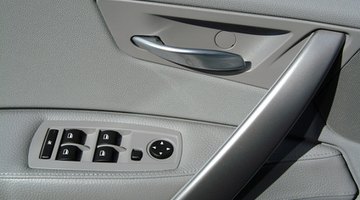How to Fix a Stuck Pocket Sliding Door

Pocket sliding doors are real space savers. Because they don't swing, you can use the 24- to 30-inch clearance you need for a conventional door for other purposes, such as a sitting area or a coat rack. A pocket door usually slides on an overhead track, and it stays in a pocket inside the wall framing when it's open. When it gets stuck, the problem is usually a loose roller, and if so, it's easy to fix. Another possibility is a misaligned or dented track. This problem isn't as easy to fix because it requires removal of some drywall.
Step 1
Grasp the latch with one hand and push the top of the door back with the other while you pull the door forward. If the screws holding the overhead rollers are loose, this should temporarily align the rollers on the track enough to make the door slide. Once the door is out, prop up the bottom and tighten the screws with a screwdriver.
Step 2
Take the door off the track if you need to inspect the track or replace a defective roller. To do this, you have to remove the split stud which frames the opening of the pocket.
Step 3
Pry the trim off the split stud with a pry bar. Remove all the screws holding the drywall to the stud with a drill and No. 2 Phillips bit. Remove the screws on the top and bottom of the stud holding it to the top and bottom plates of the wall and pull the stud out of the opening. Slide the door out, angle the bottom toward you and lift it off the track.
Step 4
Unscrew the defective roller, if there is one, and replace it with a new one. Hang the door back on the track, push it into the pocket and replace the split stud and door trim.
Step 5
Examine the track by looking inside the pocket with a flashlight. If it's bent or crooked, you need to remove a rectangular piece of drywall large enough to access it.
Step 6
Cut out drywall with a drywall saw and remove it carefully so you can reuse it. The rectangle should extend from the pocket opening to the stud framing the other side. The top of the rectangle should bisect the door header so you have something on which to screw the cutout when you replace it.
Step 7
Unscrew the defective track and straighten it with pliers or replace it. Once the track is back in position, test the operation of the door and screw the drywall back to the stud and the header with drywall screws.
Step 8
Replace the split stud and screw the drywall back to it. Replace the door trim, then tape and finish the drywall. Texture and paint the wall as needed.
Tip
Sometimes foundation settling can throw the opening in the split stud out of alignment with the door. To correct this, remove the stud and widen the opening with a tablesaw.
Tip
If you have pictures or shelves hanging on the wall, the fasteners may be interfering with the operation of the door.
Things You Will Need
- Screwdriver
- Pry bar
- Drill
- No. 2 Phillips bit
- Flashlight
- Drywall saw
- Pliers or replacement track
- Drywall screws
- Drywall finishing supplies
- Texture and paint
References
Writer Bio
Chris Deziel has a bachelor's degree in physics and a master's degree in humanities. Besides having an abiding interest in popular science, Deziel has been active in the building and home design trades since 1975. As a landscape builder, he helped establish two gardening companies.
Photo Credits
- interior panel of car door image by JoLin from Fotolia.com
- interior panel of car door image by JoLin from Fotolia.com
More Articles


